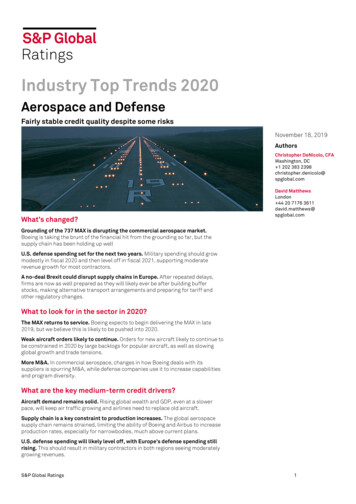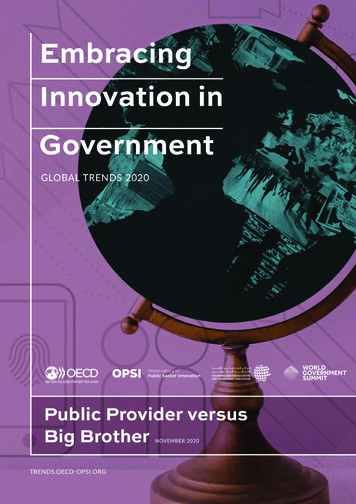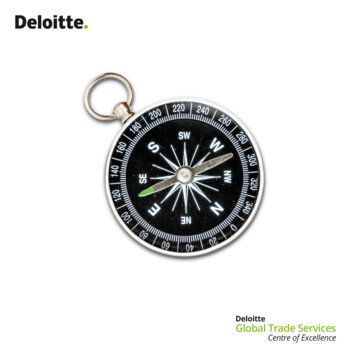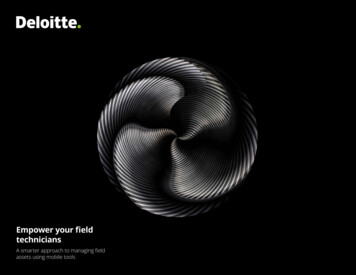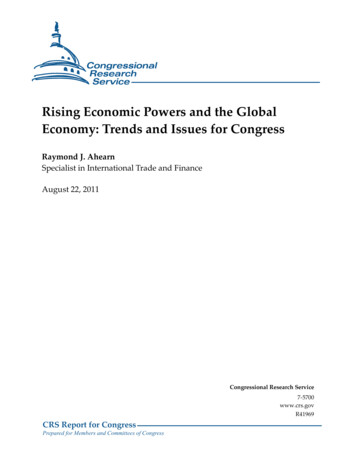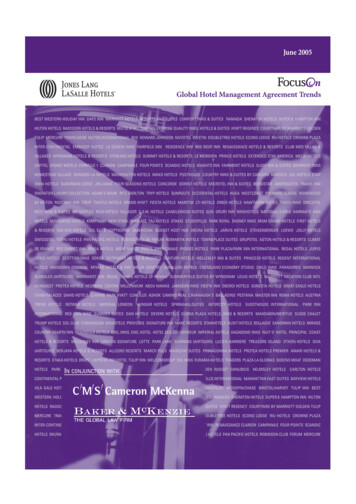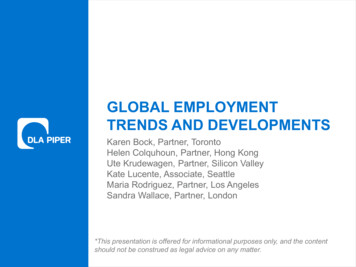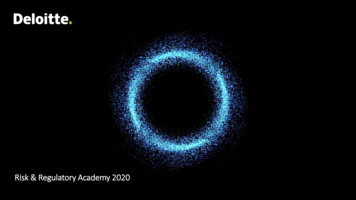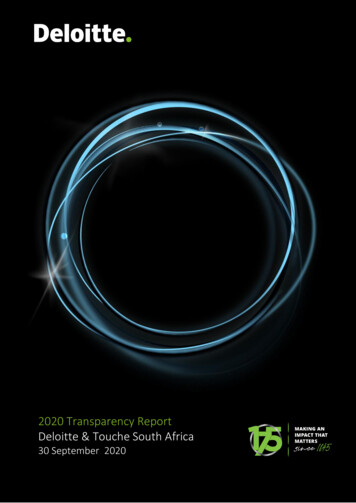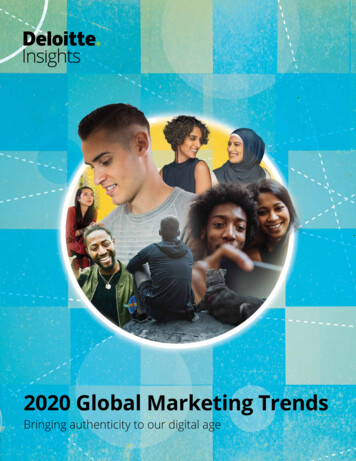
Transcription
2020 Global Marketing TrendsBringing authenticity to our digital age
About the Deloitte CMO ProgrammeDeloitte’s CMO Programme supports CMOs as they navigate the complexities of the role, anticipateupcoming market trends and respond to challenges with agile marketing.Read more on the latest marketing trends and insights.Digital technology has changed the face of business. Across the globe, Deloitte Digital helpsclients see what’s possible, identify what’s valuable and deliver on it by combining creative anddigital capabilities with advertising agency prowess and the technical experience, deep businessstrategy and relationships of the world’s largest consultancy. Deloitte Digital empowersbusinesses with the insights, platforms and behaviors needed to continuously and rapidly evolveto perform beyond expectations. Read more about Deloitte Digital’s world-class digitalagency and its service offerings.
ContentsIntroduction 2Purpose is everything 6Paying down experience debt 14Fusion is the new business blend 22Are you a trust buster or builder? 30The amplification of consumer participation 38Valuing your most important asset—talent 48Diffusing agility across the organisation 56
2020 Global Marketing Trends: Bringing authenticity to our digital ageIntroductionThe human connectionEvery industrial revolution was catalysed by a major technological evolution.Today is no different. With 90 percent of the world’s data having been producedin the last two years and more than 26 billion smart devices in circulation, weare living in an era of unprecedented technological innovation—one that hasspurred the Fourth Industrial Revolution.1OUR FIRST GLOBAL Marketing Trendsreport is, in many ways, a response to thisFourth Industrial Revolution. Yet, it’s nota technology report. For no matter which era welive in or the technology it brings forth, the humanremains constant throughout this relay ofrevolutions. This report is intended to guide C-suiteleadership in developing their strategies in thisfast-changing digital milieu, while keeping thehuman front and centre.In this spirit, we set out to explore how brands cannavigate the increasingly digitised business,economic and social environment in a way thathelps preserve—and even cultivate—their humanconnections. Through interviews with more than80 subject matter experts across the globe, weidentified seven key trends on which every businesswill likely have to focus over the next 18 to 24months to help build a socially and humanconscious enterprise. To create this report, weintegrated new research and analysis, insights fromacademic literature and stories from the field.While each of these trends varies in2
Introductionage—conversations around some are just startingto pick up in the public sphere while others havebeen noted in literature for centuries—there’s acommon thread that runs through them, one thatputs the human at the forefront of ourdigital environments.Seven trends to help brandsrefocus on the “human”Just as people expect brands to treat them likehumans and not merely as transactions, they alsoexpect brands to act more human. This means theyexpect the brands with whom they interact toembody human qualities—be steadfast andtransparent in their beliefs, consistent in theiractions and authentic in their intentions.Our seven marketing trends are anchored in thishuman-first philosophy. Among these seven, we’veidentified two overarching trends, connectingnearly all facets of business, that help brands placethe human at the centreof their work. These arepurpose and humanexperience. The firsttrend—purpose—and thefocus of the first chapterof this report, isfoundational to whybrands exist. ThoughOur hope: Putting the human at the centreof our trends exploration can help brandsforge their own path to making an impactthat matters.purpose is not new, it’smore important now than ever to direct everyPurpose and human experience unite the five otherstrategic choice across the organisation. Authentic,trends—fusion, trust, participation, talenthuman-centric purposes are differentiated in theand agility. The third chapter—fusion—highlightsmind of society in a way that’s impossible forhow purpose and human experience are togetherothers to imitate. The second trend—humanthe north star that guides brands in choosingexperience—weaves purpose across a brand’spartners with whom to engage in large, openinteractions and relationships with its customers,ecosystems. Our fourth chapter makes it clear thatworkforce and business partners, helping ensurebrands can’t accomplish purpose-driven workthat every facet of a company’s operations isauthentically without establishing trust acrossaligned with making the world better for all thethese ecosystems.people it serves.3
2020 Global Marketing Trends: Bringing authenticity to our digital ageTo help brands align with customer values, the fifthFrom the C-suite to the frontline workforce, wechapter provides guidance on how they can bringclose each chapter with specific tips on howconsumers into the ecosystem and amplify theirmarketers can better position their brands andparticipation. Chapter six discusses how talenttheir companies in this digitally connected age.should be nurtured in a manner that enablesbrands to best work toward their purpose. In theThe breakneck pace of technological change isfinal chapter, we deconstruct what it takes tosimultaneously exciting and overwhelming, full ofstructure internal operations in an agile manneropportunity and the potential for missteps. Ourthat empower brands to not only move at the speedhope: putting the human at the centre of our trendsof technology, but also slow down enough to createexploration can help brands forge their own path tomoments that matter for all people they touch.making an impact that matters.Diana O’BrienAndy MainGlobal chief marketing officerPrincipal, Deloitte Consulting LLPdobrien@deloitte.comGlobal head of Deloitte DigitalPrincipal, Deloitte Consulting LLPamain@deloitte.comSuzanne KounkelAnthony R. StephanUS chief marketing officerPrincipal, Deloitte Consulting LLPskounkel@deloitte.comUS head of Deloitte DigitalDeloitte Consulting LLPastephan@deloitte.comAndy JollyWilliam GrobelUK Partner SponsorUK DirectorDeloitte Global Marketing Trendsajolly@deloitte.co.ukDeloitte Global Marketing Trendswgrobel@deloitte.co.ukEndnotes1.Bernard Marr, “How much data do we create every day? The mind-blowing stats everyone should read,” Forbes,May 21, 2018; Statista, “Internet of Things (IoT) connected devices installed base worldwide from 2015 to 2025(in billions),” accessed September 12, 2019.4
Introduction5
2020 Global Marketing Trends: Bringing authenticity to our digital age6
Purpose is everythingPurpose is everythingHow brands that authentically lead with purpose arechanging the nature of business todayMUCH LIKE WHAT a foundation is to aNot every organisation views purpose as an all-house, a conductor is to an orchestra andencompassing ideal. Some consider it merely a toola canvas is to an artist’s masterpiece—ato advertise who they are and what they stand forclear purpose is everything to an organisation. It isto capture more market share. Others believean organisation’s soul and identity, providing bothselling quality products at the lowest price point isa platform to build upon and a mirror to reflect itsthe only thing that really matters to consumers.existence in the world. It articulates why anWhile we acknowledge instances of successfulorganisation exists, what problems it is here tocompanies in the market aligned with this thinking,solve and who it wants to be to each human itour research shows that what separates purpose-Companies that lead with purpose andbuild around it can achieve continuedloyalty, consistency and relevance inthe lives of consumers.driven businesses from the restare longevity and authenticity.Companies that lead withpurpose and build around it canachieve continued loyalty,consistency and relevance in thelives of consumers. Those thatfail to identify and articulatetouches through its work. While it’s not the firsttheir purpose may survive in the short term, buttime in history businesses are pondering why theyover time, people are likely to demand more.exist and who they are to their customers,1 thecurrent trend based on our research shows thatPurpose-driven companies witness higher marketbusinesses are using purpose to create deepershare gains and grow on average three times fasterconnections with consumers, do more for thethan their competitors, all the while achievingcommunities with which they work, attract andhigher employee and customer satisfaction.2retain talent and are achieving greater results andToday’s consumers often identify with a brand’simpact in the process.purpose, seeking to connect at a deeper level evenUNPACKING PURPOSEIn today’s world, purpose is paramount. The more businesses talk about purpose, the more it runsthe risk of becoming just another corporate buzzword. But in its truest form, purpose is differentfrom the rest. How? Purpose answers an all-important question, “Why does a company exist?”—andthe answer can serve as the beacon for all organisational decision-making.7
2020 Global Marketing Trends: Bringing authenticity to our digital ageas the brand reciprocally aligns with who they arebusiness, offering insights into why someand who they want to be.companies choose to drive business from purposeand how others can learn from such purposefulIn a recent consumer poll, Deloitte askedpractices to evolve their own thinking.respondents to share what they cared most aboutwhile making decisions about brands (seePurpose with an impactfigure 1).3Many organisations are successfully drivingOur findings revealed that many consumers todaypurpose into their businesses for three mainmake decisions based on how brands treat theirreasons:people, how they treat the environment and how1. Purpose is a core differentiator. Purpose-they support the communities in which theyoperate. When companies align their purpose withoriented companies have higher productivitydoing good, they can build deeper connections withand growth rates along with a more satisfiedtheir stakeholders and, in turn, amplify theworkforce who stay longer with them.5 Ourcompany’s relevance in their stakeholders’ lives.research shows that such companies report 30Increasingly, businesses are harnessing the powerpercent higher levels of innovation and 40and opportunity of aligning their purposes withpercent higher levels of workforce retentionsocietal good. In Deloitte Global CEO Punitthan their competitors.6 While traditionalRenjen’s Success Personified report, leaderstrends might dominate purchasing behavior,ranked societal impact as the number one way theynew opportunities exist to connect withmeasure annual performance—more than financialcustomers through purpose.performance and customer and employeeIn 2019, our consumer survey showed thatsatisfaction.4price and quality remain the biggest factorsIn the following section, we discuss anddriving customer decisions.7 However, many ofdemonstrate the significance of purpose-ledthe same respondents (55 percent) believeFIGURE 1to act on issues related to their purpose. Thosebusinesses today have a greater responsibilityTop issues consumers identify withwhile making decisions about brandsfailing to do so risk being displaced by purposedriven disruptors. For example, Unilever’s 28“sustainable living” brands (i.e., brands focusedPercentage of respondentsand increasing social impact) such as Dove,How the companytreats its ownpeople/employees28%20%19%on reducing Unilever’s environmental footprintVaseline and Lipton, deliver 75 percent of thecompany’s growth and grew 69 percent fasterHow the companytreats theenvironmenton average than the rest of its business in 2018(compared to 46% in 2017).8 Soap, petroleumjelly and tea are everyday household essentials,How the companysupports thecommunitiesin which itoperatesbut by promoting sustainable living, theseproducts became differentiated as theyembodied the company’s purpose.Source: Deloitte 2019 Consumer Pulsing Survey in theUnited States, United Kingdom, China, and Brazil.Deloitte Insights deloitte.com/insights8
Purpose is everything2. Purpose means something to all people.Purpose-driven businesses factor in the experiencesof all the humans they touch,9 as people want to workfor and support a company whose purpose is focusedon the greater good of society.10 “They are looking towork with companies that share their values, thatactively express what they are doing to be a goodpartner with the world,” explains founder and CEO ofON PURPOSE, Carol Cone, often referred to as thePurpose Queen.11 Organisations that don’t clearlyarticulate their purpose to their customers, workforceand partners may run the risk of falling behind orfailing entirely.On the other hand, brands that have an authenticrelationship with all their stakeholders can createmeaningful connections with them, enabling thosestakeholders to identify with and feel ownership ofthe brand’s purpose.12 This trend is only set tostrengthen as globally, young people today aregrowing up with a deeper sense of purpose thanprevious generations and are seeking out productsthat directly support causes about which they care.For example, 53 percent of South African millennialssuggest they’ve changed their relationship with abusiness because of the impact of its products orservices on the environment or society.13 Moreover,younger generations also want to work at companieswith an authentic purpose, with more than 70percent of millennials expecting their employers tofocus on societal or mission-driven problems.143. Purpose is who they are. Purpose-drivenbusinesses truly embed purpose in every action,aiming to leave an enduring impact on people’s lives.Increasingly, customers are looking to engage withcompanies that help them achieve their goa
Read more on the latest marketing trends and insights. Digital technology has changed the face of business. Across the globe, Deloitte Digital helps clients see what’s possible, identify what’s valuable and deliver on it by combining creative and digital capabilities with advertising agency prowess and the technical experience, deep business strategy and relationships of the world’s .

